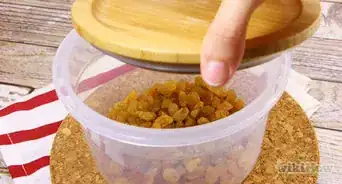This article was co-authored by Marrow Private Chefs. Marrow Private Chefs are based in Santa Rosa Beach, Florida. It is a chefs’ collaborative comprised of an ever-growing number of chefs and culinary professionals. Though regionally influenced primarily by coastal, traditional southern, cajun, and creole styles and flavors, the chefs at Marrow have a solid background in all types of cuisine with over 75 years of combined cooking experience.
There are 10 references cited in this article, which can be found at the bottom of the page.
wikiHow marks an article as reader-approved once it receives enough positive feedback. In this case, several readers have written to tell us that this article was helpful to them, earning it our reader-approved status.
This article has been viewed 389,050 times.
Blueberries are a delicious summer fruit that can be eaten plain as a healthy snack, tossed into yogurt or a salad, or used in baking. Unfortunately, improper storage can result in blueberries that are anything but tasty. In some cases, it can result in berries that are mushy and moldy. This article will show you how to properly store blueberries in both the refrigerator and the freezer.
Steps
Preparing Blueberries for Storage
-
1Sort the moldy blueberries from the fresh ones. Look for berries that have white, fuzzy mold and toss them out. The mold can be found around the stem area. You will also want to discard any berries that are too soft or wilted looking; they are too ripe and will rot quickly. Sorting the bad berries from the good ones will prevent mold from spreading.[1]
-
2Pull off any stems. Most of the stems should have fallen off on their own, but it would be a good idea to go through the berries again and pick off any remaining stems. They won't harm you if you eat them, but they will taste bitter.Advertisement
-
3Consider rinsing the blueberries with one part vinegar and three parts water. In general, you should not wash berries until you are ready to eat them.[2] Washing them too soon can lead to mold. Washing them with vinegar water, however, can kill mold spores and prevent from mold growing in the first place.[3] Put the berries into a colander or strainer, and dunk them into a bowl filled with the vinegar water. Shake the colander or strainer, then pull it out. Rinse the berries using cool water; this will get rid of any vinegar flavor.
-
4Make sure that the blueberries are dry. Any moisture left on the berries will cause them to mold too soon, so you will need to make sure that they are completely dry before storing them. There are a few ways in which you can dry the berries:
- Line the inside of a salad spinner with a few paper towels and put the berries inside. Spin them for a few seconds until there is no more moisture.
- Spread the berries out on a tray and let them air dry. Use a fan to speed up the process.[4]
Storing Blueberries in the Refrigerator
-
1Find a basket-like container and wash it well. You can use a ceramic bowl with slits in it, or you can use the original plastic basket that the blueberries came in. The container will need to have small holes in it to provide adequate ventilation.
- Avoid using anything made from metal. Blueberries can react with metal, leading to discoloration and stains on both the berries and the metal container.[5]
-
2Fold a paper towel into quarters and place it in the bottom of the basket. If you are using a larger container, such as a bowl, then use several sheets of paper towel; you do not need to fold them.
-
3Add the blueberries on top of the paper towel. The paper towel will help soak up moisture and prevent mold from developing.[6]
-
4Store the blueberries in the refrigerator. Avoid keeping them in the coldest part of the fridge, or they will get damaged from the cold.[7] The best place to store the berries is on the middle or bottom shelf. Try not to keep them in the crisper. Most crispers are too humid and do not provide enough circulation. This could lead to mold.[8] When kept in the fridge, blueberries can last five to ten days.
- The coldest part of the fridge is the top.[9]
Storing Blueberries in the Freezer
-
1Spread the blueberries in a single layer across a shallow tray. You will be freezing the berries individually first. This will prevent them from sticking and clumping together.[10] You can also use a pan, casserole dish, or baking sheet. If you are using something made from metal, consider lining it first with parchment paper to protect the blueberries.
-
2Place the tray into the freezer and wait until the blueberries are frozen. It will take about two to three hours for the berries to freeze completely.
-
3Transfer the blueberries to a freezer-safe Ziploc (resealable) bag. Pull the tray out of the freezer carefully so as not to spill any of the berries. You can scoop them into the bag by hand or simply tip the tray over the opening of the bag.
-
4Close the Ziploc bag and place it into the freezer. The berries will be good for up to one year.
- You do not need to thaw frozen blueberries before baking with them, however rinsing them with cool water until the water runs clear may help prevent them from releasing too many juices during baking.[11]
Packaged and stored properly, blueberries can be kept frozen for 6-8 months (optimal) but will still be edible after this time.
Blueberries freeze well, keeping both shape and texture when used in baking.
Community Q&A
Did you know you can get answers researched by wikiHow Staff?
Unlock staff-researched answers by supporting wikiHow
-
QuestionCan you get sick from eating old blueberries?
 wikiHow Staff EditorThis answer was written by one of our trained team of researchers who validated it for accuracy and comprehensiveness.
wikiHow Staff EditorThis answer was written by one of our trained team of researchers who validated it for accuracy and comprehensiveness.
Staff Answer wikiHow Staff EditorStaff AnswerOld blueberries are past their prime and as such, their nutritional health benefits have deteriorated. Once they’re moldy, it’s likely trichoderma, a type of mold that isn’t harmful to most humans; however, if you are allergic to mold, this can be harmful. Even if you’re not allergic to mold, the berries are not likely to taste good, may cause an upset stomach and are not nutritious. If you do eat old soft fruit and get a gastrointestinal upset that lasts more than 24 hours, see your doctor.
wikiHow Staff EditorStaff AnswerOld blueberries are past their prime and as such, their nutritional health benefits have deteriorated. Once they’re moldy, it’s likely trichoderma, a type of mold that isn’t harmful to most humans; however, if you are allergic to mold, this can be harmful. Even if you’re not allergic to mold, the berries are not likely to taste good, may cause an upset stomach and are not nutritious. If you do eat old soft fruit and get a gastrointestinal upset that lasts more than 24 hours, see your doctor. -
QuestionCan you eat blueberries if one is moldy?
 wikiHow Staff EditorThis answer was written by one of our trained team of researchers who validated it for accuracy and comprehensiveness.
wikiHow Staff EditorThis answer was written by one of our trained team of researchers who validated it for accuracy and comprehensiveness.
Staff Answer wikiHow Staff EditorStaff AnswerIf you find one moldy blueberry among the punnet and the rest are fine, then it’s okay to eat the rest. However, be sure to check closely––first, discard the moldy one, looking to see if any neighboring berries were affected too (discarding them too). Sometimes the moldy berries will “clump” together, making it easy to remove the bad part. Then, wash the berries to clean the remaining ones and do one more check before using them for food.
wikiHow Staff EditorStaff AnswerIf you find one moldy blueberry among the punnet and the rest are fine, then it’s okay to eat the rest. However, be sure to check closely––first, discard the moldy one, looking to see if any neighboring berries were affected too (discarding them too). Sometimes the moldy berries will “clump” together, making it easy to remove the bad part. Then, wash the berries to clean the remaining ones and do one more check before using them for food. -
QuestionHow long can you freeze blueberries?
 wikiHow Staff EditorThis answer was written by one of our trained team of researchers who validated it for accuracy and comprehensiveness.
wikiHow Staff EditorThis answer was written by one of our trained team of researchers who validated it for accuracy and comprehensiveness.
Staff Answer wikiHow Staff EditorStaff AnswerBlueberries can be kept frozen for 6 to 8 months. They are still edible if kept frozen beyond this time but they are at their best during the first year of being frozen. For detailed instructions on freezing blueberries, refer to: How to Freeze Blueberries.
wikiHow Staff EditorStaff AnswerBlueberries can be kept frozen for 6 to 8 months. They are still edible if kept frozen beyond this time but they are at their best during the first year of being frozen. For detailed instructions on freezing blueberries, refer to: How to Freeze Blueberries.
Warnings
- Do not wash the blueberries before storing them. Wait until you are ready to eat them. Washing the blueberries too soon will cause them to trap moisture and rot.⧼thumbs_response⧽
Things You'll Need
Things You'll Need for Storing in the Refrigerator
- Strainer or colander (optional)
- Plastic basket or similar container
- Paper towel
Things You'll Need for Storing in the Freezer
- Strainer or colander (optional)
- Shall tray, pan, or dish
- Freezer-safe Ziploc (resealable) bag
References
- ↑ Better Homes and Gardens, How to Choose, Store, Wash, and Freeze Berries
- ↑ Still Tasty, Blueberries
- ↑ Food 52, How to Keep Berries Fresh for Longer
- ↑ Blueberry Woman, How to Store Blueberries
- ↑ John Newton, A to Z of Food, p. 48, (2001), ISBN 1-74045-031-0
- ↑ Blueberry Woman, How to Store Blueberries
- ↑ Tasting Table, How to Store Fresh Berries
- ↑ The Kitchen, Washing and Storing Summer Berries: 5 Tips We Learned the Hard Way
- ↑ The Kitchen, The Best Way to Organize Your Refrigerator
- ↑ Blueberry The woman, How to Store Blueberries
- ↑ King Arthur Flour, The Secret to Baking with Frozen Blueberries: Don't be Blue
About This Article
To store blueberries, start by making sure they're fully dry so that mold doesn't grow on them in storage. Then, line a well-ventilated container, like the plastic container they came in, with a paper towel, which will help absorb any moisture on the blueberries. Put the blueberries in the container and store them in the fridge for 5-10 days. For long-term storage, spread the blueberries out on a lined baking sheet, freeze them for 3 hours, and then transfer them to a freezer bag. Store the blueberries in the freezer for up to a year. Keep reading the article to learn how to do a vinegar rinse for your blueberries before storing them!
























































